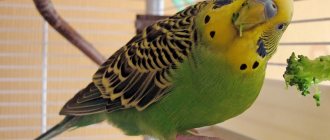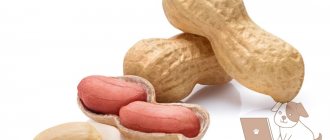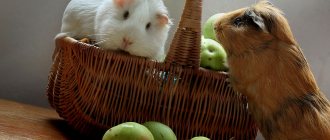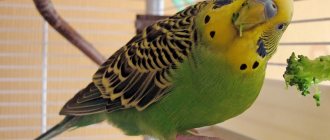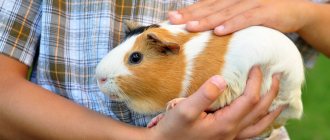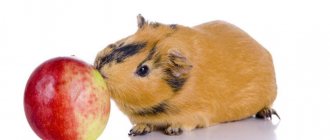Even experienced livestock breeders ask questions: what to feed their pet, whether it is possible to give certain products. Before getting a guinea pig, you should find out which foods will benefit the animal and which may harm its health. A guinea pig's daily menu should include vegetables, fruits, berries and cereals. Many vegetables and fruits can even be offered to your pet along with the peel. It is important to remember that not all foods that guinea pigs eat are equally beneficial for them. What rodents can eat and what they cannot feed a guinea pig is discussed in this article.
Basic diet
In the wild, rodents feed on tree bark and branches, leaves, berries and fruits. Fiber acts as the main source of vitamins and material that ensures the smooth functioning of the gastrointestinal tract. At home, the pig's diet is based on 3 main sources of vitamins and minerals:
- hay, meadow grass;
- vegetables and fruits;
- ready-made types of feed.
Important nuance! When choosing hay for your pet, you need to pay attention to its structure and color. Ideally, it should be soft and green. Pellet feed should be kept in the smallest quantities possible.
It is recommended to give your pet no more than 120 grams of vegetables and fruits per day. If the pet does not finish the food, it should be replaced with a fresh option. If the product rots or spoils, it can cause problems with the digestive system.
Pet diet at home
The diet of guinea pigs should be varied, but without daily experiments, which can cause problems in the animal’s digestive system. Standard set of products:
- carrots (pumpkin, zucchini, beets),
- apple (hard pears, raspberries, apricots, peach);
- white or cauliflower;
- high-quality granulated food;
- greens (parsley, dill, clover, dandelion leaves, wood lice grass);
- unlimited quantities of hay.
In the summer season, carrot and beet tops, cucumbers from your garden and fresh grass are good complementary foods.
Vegetables
Vegetables that you can offer your pig and choose the types that she tolerates well:
- carrot;
- beet;
- zucchini;
- pumpkin;
- cauliflower;
- White cabbage;
- Bulgarian pepper;
- swede;
- turnip;
- green pea pods;
- cucumbers;
- tomatoes.
Vegetable menu
The main task of vitamin C in the rodent body is to control the functioning of connective and bone tissues. Animals have to look for it from external sources, since the animal body is not able to produce it in such quantities.
Pigs' favorites on the menu most often include apples, carrots and cucumbers. Vitamin C can enter the animal's body through raw food of plant origin. It is important to give them to your pet at least 1 teaspoon per day. Veterinarians also list the following as approved products:
- Zucchini is allowed due to its high content of minerals and pectins, which normalize the functioning of intestinal permeability.
- Carrots have a positive effect on the condition of the animal’s coat and skin, as well as visual and auditory function. You can give not only the fruit itself, but also well-washed tops. Due to the content of Vitamin A, urine may turn orange.
- Bell pepper can be given to animals only during the season, due to the fact that winter varieties are oversaturated with nitrates. Only sweet varieties are allowed to serve as food.
- Pumpkin is also given to the animal almost completely. And zinc contained in the seeds is a strong preventative against helminthiases.
- Cucumbers themselves are low in calories, safe and have the ability to help digest heavy fats.
- Fresh peas are also acceptable, but in small quantities. Despite the disapproval of veterinarians. Some food manufacturers add the essence of the fruit to their mixtures, despite the fact that they can cause a negative side reaction in the animal.
- Cabbage is also allowed, but subject to proper supervision. While it causes gas in some people, excessive use can be dangerous for pigs. It is worth introducing it into the diet gradually, observing the reaction of your friend.
- Rutabaga facilitates bowel movements and helps avoid constipation. Best suited for your pet's winter diet.
- Jerusalem artichoke can be given as a treat, strictly limiting its total amount in the animal’s diet. The root vegetable itself is the most dangerous; other parts of the plant can be given constantly.
The most undesirable products include:
- Tomatoes are especially considered dangerous when green. They contain solanine, in addition, the use of tops is also not recommended. Ripe tomatoes, due to the destruction of poisons, can be included in the diet in small quantities. If you overdo it, the animal may experience intestinal upset and problems with the gastrointestinal tract.
- Potatoes are prohibited due to starch and solanine.
- Melon has a risk of developing diabetes due to the abundance of sugars.
- Radish and radish oils can cause bloating.
- Beetroot has a stable effect and is not particularly recommended for pregnant females. Root vegetables and tops are recommended for healthy individuals in small quantities. After eating beets, the animal’s urine may temporarily acquire a red tint.
- Corn is prohibited for pigs; only tops are allowed. And grains contain a large amount of starch, which can cause obesity.
Tree branches
Twigs, leaves and any other parts of the following trees are contraindicated for guinea pigs: cypress, yew, holly, thuja, robinia, buckthorn.
The pet is also not allowed to eat acorns, nuts and chestnuts, but is allowed to try the branches of these trees from time to time. In small quantities they will not cause harm.
What drinks can you give your guinea pig?
Just remember that it is safe for pigs to drink only plain, clean water. Bitter, sweet, carbonated and alcoholic drinks are prohibited. At best, they will cause severe stomach upset, and at worst, the death of the pet.
Allowed fruit menu products
Despite all the benefits of a fruit diet, fruit consumption by animals must be dosed. This restriction is introduced due to the high sugar content, which can cause diabetes or obesity. Despite the wide variety of fruits, the pig is allowed only apples in almost unlimited quantities. The seeds from the fruit should be removed, they contain dangerous poisons. Berries in diets are allowed only from the permitted list:
- Grapes contain a large amount of fiber, which has a beneficial effect on the functioning of the gastrointestinal tract.
- Watermelons can be given in the form of pulp. But they have a diuretic effect, so they should be dosed.
- Rowan contains healthy carotene, as well as vitamins C and P.
These types of berries are considered permitted, but there are also controversial fruits:
- A number of citrus fruits provoke irritation of the mucous membrane and can cause allergies.
- Strawberries are fraught with an excess of vitamin C. It can lead to ulcers and gastritis. In safe quantities, seasonal berries can be given no more than a couple of times a week.
- Although they can replenish glucose and fiber, they can also cause excess calories and lead to obesity. Their use should be kept to the minimum possible.
It is important to note that rodents are still herbivores. Meat and dairy products should be avoided in the diet.
Can rodents eat exotic fruits?
Guinea pigs are allowed to give bananas, grapes, and some types of imported fruits, but how much can be offered to a particular animal is determined by the doctor individually, after examining and weighing the animal.
This takes into account:
Exotic fruits can provide a complete diet for your pet, saturating it with essential vitamins and microelements, especially potassium (bananas), calcium and phosphorus (kiwi, persimmon, melons). With a lack of vitamin C, rodents sometimes experience paralysis. For an animal to be healthy, it needs 15 mg of vitamin C per 1 kg of live weight every day.
Can guinea pigs eat bananas?
Experienced breeders of domestic rodents advise including exotic delicacies in the animals' diet in the smallest quantities and as rarely as possible (1-2 times a week). The one-time norm for one animal is 1–2 pieces of banana, 5–10 g each. You can feed your guinea pig 1 small banana per day, provided that the pet is healthy and tolerates this type of treat well.
Such fruits require careful (preliminary) processing. A huge amount of pesticides accumulate on and inside banana peels. Therefore, unpeeled fruits should be washed in running water, doused with boiling water and only then peeled.
A guinea pig can have a banana, but not a banana peel. The peeled fruit contains a lot of useful fiber and vitamins. But due to repeated chemical processing of fruits, there is a high probability of some of the chemicals getting into the tissues of the fruit. Therefore, experts recommend including bananas in the diet of guinea pigs as rarely as possible. In addition, fruits contain a lot of sugar, which can cause problems with the digestive system in rodents.
Important! Most exotic fruits (pineapples, papaya, mango, guava) contain a lot of sucrose. Their presence in the diet of domestic rodents is extremely undesirable. Exceeding the norm of such products, as a rule, causes digestive disorders that are dangerous to health.
The fruits are extremely beneficial for guinea pigs. They contain a lot of folic acid, iron, calcium, magnesium, phosphorus, and vitamin E. Kiwi is included in the animals’ diet 1-2 times a month.
It is recommended to offer animals solid fruits, and not to allow the amount eaten to exceed the norm (1-2 quarters of a round piece per day). Kiwi is especially useful for female guinea pigs who are expecting offspring or feeding newborn babies.
Grape
For pet rodents, you should choose seedless varieties, such as sultanas. You can treat the animal with grapes no more than 1–2 times a month, in limited quantities (20–30 g per day). The reason is still the same - excess sucrose content.
The grapes should not be unripe or overripe. Feeding animals with rotting berries is completely unacceptable.
Interesting! Avocado fruits are toxic to guinea pigs. Eating them leads to prolonged diarrhea and digestive disorders.
Persimmon
Sometimes these fruits are called Chinese peaches; they contain a lot of fiber, a huge amount of vitamins, pectin, and iodine. It has been noticed that when they are eaten, the functioning of the digestive system is noticeably improved and immunity is increased.
Persimmon is very beneficial for guinea pigs. But you shouldn’t give them fruit often, so as not to provoke an increase in blood sugar. If an animal is prone to constipation, it is better to avoid persimmons in its diet.
The optimal number of treats per week is 2 times. You should give treats little by little and control the correct distribution of the amount of fruit between all neighbors in the cage.
Important! Persimmon is incompatible with milk and water.
Solid food
Solid (roughage) food consists of grains, hay, and special food in granules, which is available in pet stores. You don’t have to give special food, but when there is no grass or hay, it is the best option. These animals love to eat this food, just as birds peck their favorite grains. Now you can buy ready-made feed in granules, intended specifically for these animals; these granules contain vitamin C. The feed contains this vitamin, it should not be stored for a long time, no more than three months. This food must be stored in a dry place, in tight packaging, otherwise it may become moldy and spoiled, becoming unsuitable for consumption.
Melons
What does a guinea pig eat, besides all of the above? Melons (pumpkins, melons, watermelons, etc.), which contain many vitamins and carotene. They should be given to the rodent in slices with peel. Zucchini and pumpkin are especially useful for these animals. They serve as dietary food. are a preventative against worms. In addition, they contain many vitamins and microelements. They are also an excellent source of zinc. This element is necessary for the prevention of skin diseases and maintaining the skin in good condition.
Green food
This food must be given to your guinea pig, but you need to know what kind of greens you need to give your pet. The main herb is fresh grass from fields and meadows with medicinal and spicy herbs. You shouldn’t tear up greenery at the edge of the road, as many cars pass by and exhaust gases settle on the grass. It is not recommended to collect grass under trees either; birds like to sit on trees, and their droppings cause rotting of the greenery. Pigs love grass, it helps them always stay healthy. Greens contain many vitamins. Greenery includes not only field grass, but also that which a person eats. These animals love to eat: spinach, the stem and greens of dill, parsley, it’s worth giving a little, and lettuce and other greens.
Indoor flowers
During walks outside the cage, the animals sometimes gnaw on some indoor plants. This must be stopped immediately because most domestic plants are poisonous to pigs. It is better if the pots are located in places inaccessible to rodents.
The most popular indoor plants that are dangerous for pigs:
- azalea;
- ficus;
- lilac;
- jasmine;
- chrysanthemum;
- dahlias;
- geranium;
- lily;
- Dracaena broom.
Palm trees and cacti should also be kept away from a curious pet.
Combined feeds
In order for the animal to receive enough nutrients, give it regularly green grass, fresh berries, fruits, vegetables, hay, all this is necessary for your animal. This is the best nutrition for your pet to provide at home. There are also different feeds with herbs and fruits for pigs. The feed also contains grains, dried fruits and honey. A guinea pig can eat only natural products; food is not mandatory in its diet, but many owners of these animals still buy that food. There are many advertisements for different foods, but you don’t need to feed your pet exclusively food.
You should not give your guinea pig food that contains:
- bone meal (in nature, guinea pigs do not consume animal products);
- nuts;
- corn based syrup;
- preservatives.
What other foods are contraindicated for pigs?
What is not poisonous to humans can be destructive to the delicate body of a guinea pig.
Products that should be included in the diet in very small quantities:
- hazelnut;
- Walnut;
- seeds (sunflower, pumpkin, dill, sesame).
Sweets should never be given to a rodent. Candies, chocolate, marshmallows, halva are heavy foods that will lead to poisoning. Even the smallest amount of chocolate acts as a strong poison on the pig’s body.
You should not tempt fate and give the animal exotic fruits, no matter how much he begs for them. The pig is not given baked goods (including crackers, bagels), cookies, boiled porridge, soups and borscht in any form. The digestive system of these animals is not adapted to thermally processed foods.
Berries and fruits
Natural berries and fruits contain the bulk of the vitamins your guinea pig needs, not just the treats your guinea pig loves. Fruits are not forbidden to the animal; they can be included in the daily diet, the animal will choose what it likes more, and advice from a veterinarian on nutrition is also possible. Veterinarians do not recommend giving your guinea pig a lot of sweet fruits. They are more likely to have indigestion, which occurs more often in them than in other rodents. A large number of sweet tangerines, apples and pears can cause just such a disorder. Give tangerines to your pet with particular care. They are, of course, an essential source of vitamin C, which the pig's body does not produce, and citrus fruits are the main source. But tangerines are strong allergens. You can give a little, a slice every day and watch the behavior of the guinea pig to see if it has developed an allergy.
What to feed a pregnant guinea pig and newborn babies
Pregnant rodents need high-quality and nutritious nutrition. Rose hips, which are served to pets in the form of an infusion, are very beneficial for the body. You should also include wheat sprouts, beets and fresh carrots in your daily diet.
The diet of newborn pigs should contain foods rich in vitamins and proteins. For the first two weeks, babies feed on mother's milk. If it is missing, the owner will have to feed the small offspring; it is better to consult a veterinarian for advice.
Already from the second day of life, little guinea pigs begin to try different foods, so it is necessary to ensure that the cage contains:
- Juicy;
- Greens;
- Industrial feed.
Water
Every animal needs water and the guinea pig is no exception, although some breeders think differently, thinking that if the animal eats a lot of green grass, then it does not have such a need for water. But this opinion is not correct. All pigs need water, especially in hot weather and also for pregnant and lactating females. Fresh water should always be provided. It is better not to give a mug a drinking bowl, the water in it quickly becomes not fresh; for water it is better to take bottles - drinking bowls.
When it's hot outside, you can give the animals an open shelf so they can dip their paws in it. This cools the animal's body.
Dairy
Can guinea pigs have milk?
Giving milk to guinea pigs is not recommended. The enzyme that is responsible for the breakdown of milk sugar (lactose) is found in insufficient quantities in the body of animals. If your pig drinks milk, the lactose will cause diarrhea and bloating. More serious diseases may develop in the future, so it is better to show your pet to a doctor.
Females can and even need to be given milk during lactation. You can soak crackers in milk and offer them to your pig.
The ban also applies to other dairy products: cottage cheese, cheese, yogurt and others.
What food is prohibited
Guinea pigs are not carnivores, they do not drink milk or eat meat products, they are true vegans.
When thinking about what to feed your pet at home, do not give him:
- porridge;
- dairy products, cheese and cottage cheese;
- meat and fish products;
- vegetable stew;
- eggplant;
- raw potatoes;
- night blindness;
- fern;
- sow thistle;
- wild rosemary;
- celandine;
- fighter.
You also shouldn’t give overripe or unripe fruits, vegetables, damp grains, old mixed feed; you also shouldn’t feed the rodent what you eat yourself every day. Do not give a lot of sorrel to your pet, it is not prohibited, but in small quantities.
The option is to give the animal store-bought food a couple of times a day, this is of course also an option, but how correct is it to feed the pig only this. This is suitable if the animal is not yours, and you were simply asked to look after the pet. But this is not the best option if you purposefully got yourself this pet. You should not care about the health and condition of your pet or how long your friend will live.
Necessary for care
Like any other pet, a guinea pig requires a wide variety of grooming accessories. These include:
- cage or aquarium;
- feeder;
- sippy cup;
- house;
- filler;
- mineral stone;
- toys;
- carrying;
- hygiene products;
- brush-comb and nail clipper.
Cage or aquarium
Keeping a guinea pig is allowed both in an aquarium and in a cage. The main condition is size: the dwelling must be at least 50 cm in length and 30 cm in height so that the animal can move comfortably. If you have decided on a cage, then it is best to take a closer look at the options that have a plastic bottom. Plastic is quite easy to care for, it is easy to wash, dry, etc. A wooden base is not suitable due to the fact that these animals drink a lot of liquid per day, and therefore excrete a large amount of urine. The wood will simply become unusable in a very short time. You can purchase an aquarium in the above sizes. It, like a cage with a plastic bottom, is easy to wash and clean. But you should be careful, since glass is a very fragile material and when moving it, for example, to another room, you should follow safety rules (the pet should not be in the aquarium, it should be transferred to a carrier).
cell
Feeder
The feeder should be heavy enough so that the guinea pig cannot knock it over. An excellent option would be bowls made of ceramics, stainless steel, etc. It is also recommended to buy 2-3 containers. For example, one will be used for vegetables or fruits, and the second for dry food.
Sippy cup
A vertical ball sippy cup is perfect for a guinea pig. It is usually made of plastic with a metal tip. In such a drinking bowl there is no need to change the water daily, but this is done about 2-3 times a week.
House
Be sure to install a small house in the cage or aquarium. Your pet will sleep in it, relax, or simply retire when he wants to be alone. Most often, such houses are made of wood with a round “door” cut out in the middle. The most optimal size is 25 cm in length and 15 cm in height. This space is enough for the animal to hide and at the same time feel comfortable.
house
Filler
When arranging the cage, do not forget about the bedding. It will create comfort in the cage, prevent the animal from freezing and, to some extent, maintain cleanliness. You can use sawdust or ground corn cobs as a filler. Under no circumstances put cotton wool, newspaper, paper, etc. in the cage as bedding, as this is not safe for your pet’s health.
Mineral stone
To maintain dental health and calcium levels in your guinea pig's body, mineral stone is essential. After all, it serves not only as a vitamin complex, but also perfectly helps the animal grind its teeth. This stone is sold in a pet store, and its price is quite affordable.
stone
Toys
Guinea pigs are somewhat similar in behavior to decorative rabbits. They love to play. Therefore, be sure to buy some interesting and funny toy for your pet, for example, a tunnel, a hammock, a mirror, a rolling wheel, etc. The game will not only bring joy and pleasure to the animal, but will also strengthen muscles, and will also be an excellent preventive measure against obesity.
Carrying
If your plans did not include traveling together or any trips with your guinea pig, then you will still need a carrier. Transporting an animal in your arms, in a box or blanket is strictly prohibited. For example, you need to visit a veterinarian or transport the animal to another house or apartment; in such life situations, a carrier will definitely help you out. The pig will feel safe and the transportation process will go smoothly.
Hygiene products
Guinea pigs are considered clean animals, but sometimes they are still allowed to be bathed. For such cases, it is necessary to use special hygiene products that can be purchased at a pet store. The most popular of them:
- “Biogance” – bio-perfume;
- “Veda” – wheat shampoo.
Brush-comb and nail clipper
Caring for your guinea pig's coat and claws is extremely important. To do this, you need to purchase a special comb with soft bristles (combing is done daily), as well as a nail clipper for trimming the claws (the procedure is performed as they lengthen).
Method for preparing sprouts for pigs
Guinea pigs love green shoots. This is a very useful product for pets. Guinea pig oats can also be sprouted at home. After two weeks, the regrown grass is cut back for further growth. Unpeeled oats are used for germination. You can buy it at your local pet store. A small layer of sawdust is poured into a shallow container. Then they are pressed and oats are sown on top. Fill everything with warm water once a day, drain off the excess. Watering should be moderate so that mold does not form and the shoots do not die. A growing vegetable can be cut several times because it will grow back.
What is harmful for pigs?
Some products are given to animals in limited quantities. They may not lead to severe poisoning, but they will definitely upset the rodent’s digestive system.
Vegetables
List of vegetables that are not suitable for a pig's daily diet or that should be completely avoided:
- Tomatoes. Despite its nutritional value, a high content of acids (including citric, oxalic, abscisic) when fed daily will irritate the delicate stomach of rodents. Therefore, a piece of tomato should not be given more than once a week.
- White cabbage, cauliflower, Brussels sprouts, red cabbage. It contains a rich set of microelements, but the animal's digestive system is not designed to digest large quantities of cabbage leaves, which can cause severe diarrhea.
- Legumes are given only in the form of young sprouted stems. Boiled or raw peas and beans cause bloating and poisoning. Let's say a small amount of fresh peas.
- Potato. Eating large amounts of starch is harmful to the animal. Potato tops are a powerful poison.
- Radish, radish. Contains harsh essential oils that may cause serious damage to the digestive system. Therefore, there is no need to include them in your diet.
- Garlic and onions should absolutely not be eaten by animals to avoid burns to the esophagus.
- Pepper is available in limited quantities. This may disrupt digestion. Giving hot pepper is strictly forbidden.
Fruits, berries
List of unwanted and prohibited fruits and berries:
- Sour apples are contraindicated for pigs.
- Lemon is strictly contraindicated for animals; it is a strong acid.
- Oranges and tangerines, peeled and peeled, should be well ripe and sweet. Citrus peels are poisonous to rodents. Also, mumps may have individual intolerance.
- Pears are chosen from hard varieties to avoid diarrhea.
- Banana is harmful because it can cause obesity.
- Melons (watermelon, melon) contain a lot of harmful sugars and weaken the stomach. Their use is limited.
- Stone fruits (plums, peaches, apricots, cherries) are too sweet and upset digestion.
Dried fruits are not on the list of prohibited foods. However, they must be prepared without the use of preservatives. You should not get carried away with them so that your pet does not have diabetes.
Animal products
Unlike hamsters, guinea pigs do not require pet food. Their digestive system is capable of digesting only plant foods. You cannot offer them milk, cottage cheese, butter, meat, eggs, or fish. In their natural habitat, such food is not eaten.
Herbs
Care must be taken when selecting grass and hay. It is enough for an animal to eat a small amount of a poisonous plant for it to become poisoned.
Poisonous herbs include: celandine, datura, spurge, lily of the valley, poppy, hemlock, mustard, calendula, foxglove, rosemary, night blindness, hellebore, buttercup, wrestler, lark. You should limit the use of St. John's wort, milk thistle, coltsfoot, dandelion, and wormwood.
The animal should not eat aromatic herbs such as mint, thyme, sage, and basil.
When there is doubt about edibility, such vegetables are not offered to the rodent.
Indoor flowers
Indoor flowers are very poisonous. Common plants such as aloe, monstera, kalanchoe, cyclamen, ivy, dieffenbachia, philodendron, spathiphyllum, viola should not be within the reach of animals.
If your pet has enough food, he will not try houseplants. Situations vary, so flower pots should be raised above the floor.
General feeding rules
- dry food – 5-10% (no more than a tablespoon);
- juicy food – 30%;
- hay – 60%.
If there is no dry food on the menu, an adult pig should eat approximately 150 g of vegetables per day
. She is served vegetables every day, and is occasionally pampered with berries and fruits. Vegetable dishes must be supplemented with leafy greens, which compensate for the lack of vitamins.
Do not keep your rodent on a mono-diet, feeding it only carrots or beets: this will cause health problems. It’s great if there are different products on his table every day: parsley will be replaced by dill/basil, and celery by carrots/zucchini. A typical daily diet consists of three types of vegetables and herbs.
Important!
Do not collect plants near highways, factories, or in swampy areas. Dry the grass for at least 1.5-2 months: it should not be blackened or rotten.
Do not forget to establish an uninterrupted supply of hay (especially during the cold period): the guinea pig chews it constantly, without limiting itself in volume. Hay normalizes digestion and is necessary for proper grinding of teeth.
Legume and legume-cereal hay is considered the most valuable. The rodent will also thank you for the vitamin herbs (nettle, alfalfa and clover) that you will prepare in the summer. These plants will be an excellent feed for growing and pregnant animals.
Feeding technology and precautions
How to feed guinea pigs correctly? It is best to give concentrates in the morning and at night. And put succulent food in the cage when you are at home, so that the remnants of this food can be removed after the meal. The rodent should always have hay in its cage, as well as a mineral salt stone.
Please note that guinea pigs cannot tolerate starvation. A rodent that refuses to eat for some reason may develop dehydration and exhaustion. If you notice anything wrong with your pet, do not hesitate and contact a doctor immediately.
Guinea pigs have a habit of constantly chewing something. It can serve them badly. After all, excessive consumption and a sedentary lifestyle can lead to the development of obesity. This pathology, unfortunately, very often appears in domestic rodents. Have you noticed that your pet has gained weight? Take steps to lose weight immediately. After all, animals that are obese lose their ability to reproduce, and their immunity also decreases.
In order to make the right guinea pig, the recommendations of veterinarians should be considered first. After all, each rodent is special, and it is possible that your pet will need more green vegetables, or, conversely, some foods will need to be removed because the pet has gained excess weight.
Ready mixes
If the owner acquires a guinea pig for the first time, he should carefully prepare for creating a menu. You can also use ready-made mixtures. At different prices, the content of microelements in the feed is approximately the same. Caring owners should not abuse ready-made food. Due to the large amount of calcium and proteins contained in it, stones can be deposited in the animal’s kidneys. This type of food has a negative effect on the urinary system. The granulated mixture can cause diabetes and obesity in rodents. Store-bought food and mixtures are best given to pregnant or lactating females, as well as to cubs from one month old.
Oatmeal can be given as a ready-made food. They should be supplemented with a sufficient amount of lush greens in summer and hay in winter. Oatmeal and corn products can be given in the form of bread or croutons. But this should not be the basis of the diet. For the health of the animal, the menu must contain at least three components.
Feeds consisting of 3-6 types of grain are considered simple and cheap. More expensive foods include 15 or more components. They contain a wide range of protein supplements, vitamins and microelements. Their safety is ensured by vacuum packaging.

